Helping people with paraplegia walk again
Walking despite paraplegia: at an event in the run-up to Cybathlon 2020, two teams consisting of students, researchers and people with disabilities show that it can be done. Highlights from the Cybathlon Experience.
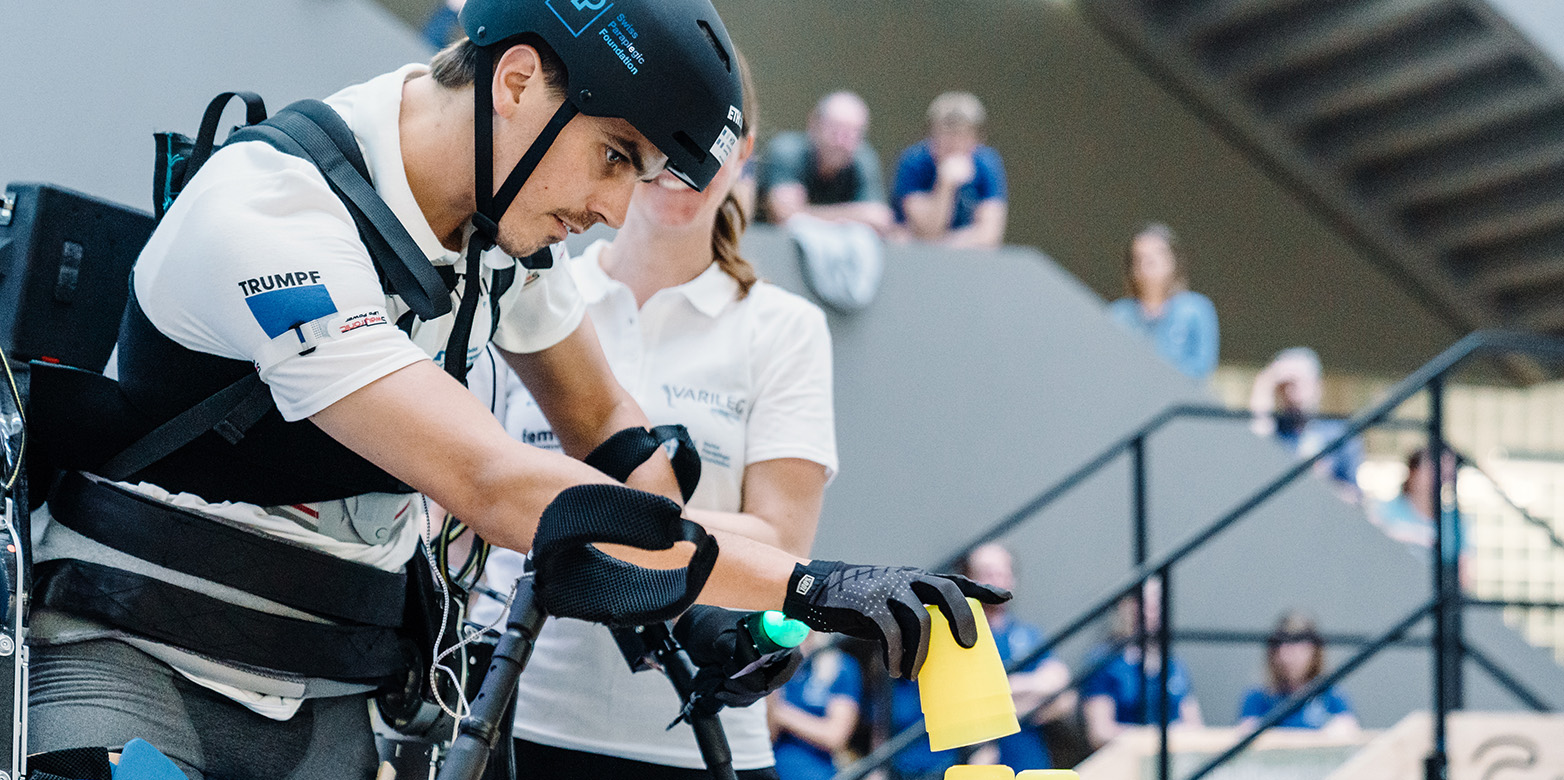
Tension is mounting in the atrium of the research centre at HSR University of Applied Sciences Rapperswil. The viewers in the galleries are holding their breath, and you can almost hear a pin drop. The throaty sound of a motor breaks the silence, followed by applause. Rolf Schoch, a 30-year-old man with paraplegia, gets up from a wooden bench and begins to walk. His body is encased in a compact, 35-kilogramme exoskeleton – a wearable, powered support system that enables paraplegics to stand up, walk and climb stairs.
At what has been dubbed the “Cybathlon Experience” at HSR, two teams are keen to demonstrate how this is possible: one team called VariLeg enhanced, piloted by Rolf Schoch, the other called Project March, piloted by Sjaan Quirijns. Both teams will be taking part in the Cybathlon in May 2020, a competition launched by ETH Zurich in which people with physical disabilities compete against each other to complete everyday tasks using robotic assistance systems. The two teams are taking the opportunity of the Cybathlon Experience to present their exoskeletons to the wider public. These exoskeletons enable Sjaan and Rolf to talk with others on an equal footing and complete everyday tasks – something Rolf demonstrates by stacking cups on a table. In order to accomplish this, the pilot has to let go of one of his crutches, relying fully on the exoskeleton to hold him in an upright position.
Same goal, different starting points
Getting to this point wasn’t easy. To compete in Cybathlon 2020, both teams had to develop their robotic exoskeletons under enormous time pressure and in close cooperation with their paraplegic pilots. Though the student teams were pursuing the same goal and displayed similar levels of motivation, their starting points couldn’t have been more different.
VariLeg enhanced, a team of 15 Bachelor’s students from ETH Zurich and HSR, took just eight months to get their exoskeleton up and running, collaborating in a focus project throughout the final year of their studies. Comprising mechanical and electrical engineers as well as health scientists, the team invested a lot of time in their assistance system, says mechanical engineer Michael Heid: “Seventy-hour weeks were the norm, and that sometimes rose to 90 hours in the critical phase.” And lectures? “Well, we might have attended some.” But Michael lived primarily for the focus project – not least because of the people in his environment with paraplegia. So he and his team had correspondingly high expectations of their final product. Although earlier focus projects had developed an exoskeleton, VariLeg enhanced started more or less from scratch. As Michael explains: “Obviously we talked to our predecessors, and they gave us some valuable tips, but the concept we pursued wasn’t comparable to theirs.” The VariLeg enhanced team wanted to position the exoskeleton’s motors differently, and the materials and control unit they used were totally new compared with the previous model.
A break in their studies
Things were different with the Dutch team, Project March. The 23 students from 7 different disciplines at Delft University of Technology interrupted their Bachelor’s and Master’s courses for one year to work on the exoskeleton in what they call the Dream Team. Over a period of one month, their predecessors shared with them all the expertise they had gained in the course of their own project. The fourth-generation Dream Team then spent a year constructing a new version of the existing exoskeleton called March IV – with the knowledge and occasional support of the old team. Sjaan Quirijns, the exoskeleton pilot, was on board from the start. Thanks to the valuable experience with exoskeletons she had gained working with the previous team and in other research projects, she was able to provide the new team with optimum support.
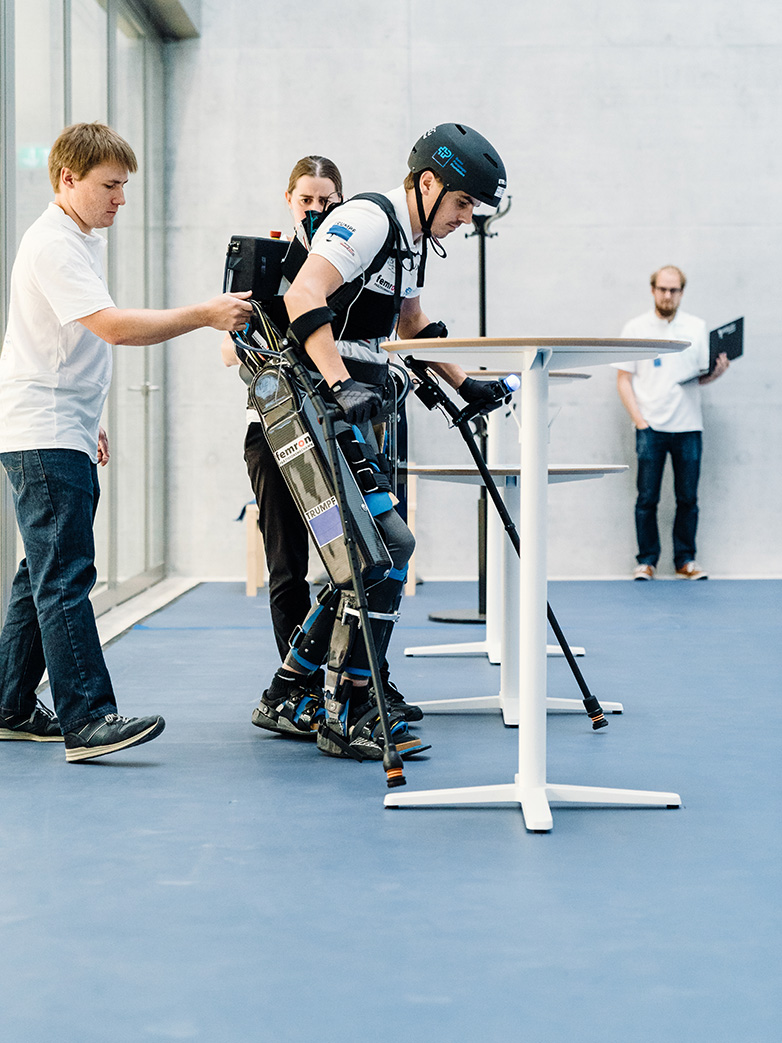
Rolf, the pilot of the VariLeg enhanced exoskeleton, has spent significantly less time practicing with the powered support that is now enabling him to walk at the Cybathlon Experience. The tension is evident in his face as he completes the slalom test, navigating his way between bar tables with long, even strides. He activates each step by pressing a button on one of his crutches. Each step forward is accompanied by the mechanical whirring of the robot – and by two helpers, ready to catch him if the motor fails.
VariLeg enhanced no longer consists solely of ETH and HSR students. Following the roll-out of the focus project in May 2019, the exoskeleton was handed over to the Rehabilitation Engineering Lab and Product Development Group at ETH Zurich and HSR’s Institute for Lab Automation and Mechatronics. The students were determined to hand over the exoskeleton – along with the expertise on which it is based – in such a way that the researchers could continue working on it seamlessly. In addition, Lukas Granzotto, one of the three team members from HSR, was able to secure a temporary position in the HSR lab, enabling him to make a key contribution to the smooth transfer of expertise and also stay involved in the project a while longer. His team colleague Michael Heid was certainly happy to have completed the project after eight months of intensive work. “But of course it was a shame to let go of a project that is so close to my heart,” he says.
Sideways through the obstacle course
Having reached the end of the row of bar tables, the tension in Rolf’s face gives way to a relieved smile, and he lifts up one of his crutches in a gesture of triumph. The visitors applaud enthusiastically and the VariLeg enhanced team members are clearly proud. For them, it’s the end of today’s demonstration. Rolf attempts neither the sideways slope nor the stairs in the obstacle course, having had no opportunity to train for these in the brief two months at his disposal. As Lukas says: “If the Cybathlon Experience hadn’t come around, we would probably have coached Rolf to tackle other obstacles, made certain changes and carried out tests. But since the exoskeleton was already working so well, we didn’t want to tinker with it anymore. Never change a winning team!”
While Rolf is giving a brief interview at the end of the obstacle course, the Project March team starts preparing for its demonstration. Sjaan is sitting in her wheelchair. At this point, she would normally haul herself into the empty exoskeleton sitting on the bench beside her. But this time the demonstration will take place without a pilot, which has nothing to do with her and everything to do with the technology. A few hours before, the March IV exoskeleton wasn’t able to move forwards and had to be repaired. As the team had no time to test the system prior to the demonstration, safety dictates the exoskeleton remain empty and tackle the obstacles without a pilot, but in the company of three helpers.
Standing up, tackling the slalom, balancing on the sideways slope and climbing stairs – none of that poses a problem for March IV. On the slope the team presents its latest innovation: the exoskeleton moves sideways, the hip motors slowly shifting one leg after the other to the side. Though specially developed for the sloping surface, this sideways movement also helps the pilot retain his or her balance when walking straight ahead.
Not ready yet for everyday use
While the two exoskeletons can do a lot, they’re not yet suitable for everyday use. From the outset, VariLeg enhanced’s exoskeleton was conceived for the obstacles of Cybathlon 2020. To this end, the movements of a person walking through the obstacles were recorded and programmed into the software. Whereas Sjaan can choose between three steps of different lengths on the crutch display of her exoskeleton, Rolf has only one at his disposal. What’s more – unlike March IV – the ankles of the VariLeg enhanced exoskeleton cannot be moved. “It’s not necessary for the obstacles in the Cybathlon and would require additional motors that would increase the weight of the exoskeleton,” says Lukas.
Project March has a different take on this: mobile ankle joints are extremely useful for a natural gait and to tackle obstacles efficiently. The Dutch team is convinced that the exoskeleton needs to be as comfortable and suitable for everyday use as possible in order to win the Powered Exoskeleton Race category at the Cybathlon.
Looking forward to the Cybathlon
Both teams have their work cut out for them in the run-up to Cybathlon 2020: Sjaan will train with the new Dream Team, while development of the VariLeg enhanced exoskeleton will continue under the leadership of HSR. Immediately after the Cybathlon Experience, the researchers take the exoskeleton apart to ensure that everything is still intact after the intensive training and demonstration sessions. They also want to make some changes to the system. “We’ll start by addressing the things the students simply didn’t have time for during the focus project,” says Silvia Rohner, a lab worker at HSR. That includes, for example, optimising the code and properly documenting everything. At Rolf’s suggestion, they will also be reducing the time taken to complete each step in order to improve balance.
Right now, Sjaan, the Project March pilot, is making her way through the Cybathlon Experience obstacle course at a relatively rapid pace. Having successfully completed the course with an empty exoskeleton, the team is now attempting a run-through with a pilot. As Sjaan makes her way down the last steps of the stairs, the Dutch team is greatly relieved – and clearly looking forward to Cybathlon 2020.
Cybathlon Experience “Next generation exoskeletons”
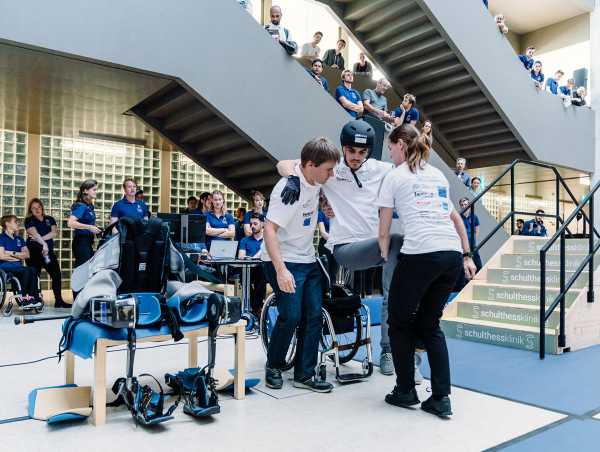 First step on the obstacle course: encased in the exoskeleton, Rolf Schoch has just got up from the bench.
First step on the obstacle course: encased in the exoskeleton, Rolf Schoch has just got up from the bench. Pilot Sjaan Quirijns of Project March is highly experienced.
Pilot Sjaan Quirijns of Project March is highly experienced.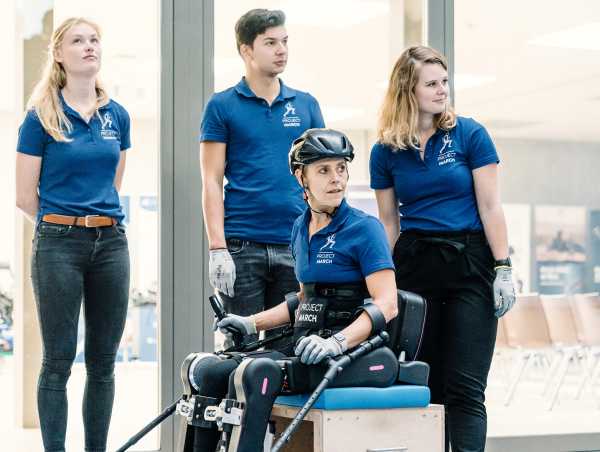 Even sideways steps are possible with the March IV exoskeleton.
Even sideways steps are possible with the March IV exoskeleton.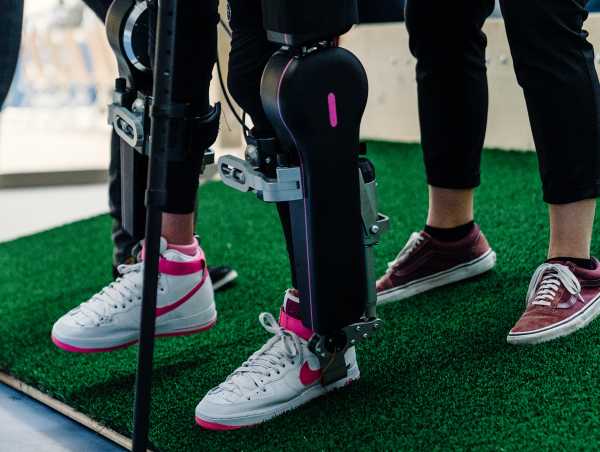
Cybathlon 2020
The Cybathlon is a unique championship in which people with physical disabilities compete against each other to complete everyday tasks using state-of-the-art technical assistance systems. The first competition organised by ETH Zurich was successfully launched in 2016. The gates of the SWISS Arena in Kloten near Zurich will be opened for the continuation of the Cybathlon on 2–3 May 2020. Tickets: external pagewww.cybathlon.com/ticketscall_made
The Cybathlon is supported by numerous partners, including maxon, Schulthess Klinik, EKZ, Stavros Niarchos Foundation, BNP Paribas, Ernst Göhner Foundation, Swiss Paraplegic Foundation, the City of Kloten, the Cerebral Foundation, MBF Foundation, Pro Infirmis, PluSport, Hocoma and Balgrist University Hospital. The ETH Foundation is looking for additional partners. Support the Cybathlon: external pagewww.ethz-foundation.ch/en/cybathloncall_made
This text has been published in the current issue of the Globe magazine.
CYBATHLON 2020 will take place on 13 – 14 November 2020 – globally and in a new format. Further information
